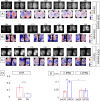Glioblastoma disrupts cortical network activity at multiple spatial and temporal scales
- PMID: 38802334
- PMCID: PMC11130179
- DOI: 10.1038/s41467-024-48757-5
Glioblastoma disrupts cortical network activity at multiple spatial and temporal scales
Abstract
The emergence of glioblastoma in cortical tissue initiates early and persistent neural hyperexcitability with signs ranging from mild cognitive impairment to convulsive seizures. The influence of peritumoral synaptic density, expansion dynamics, and spatial contours of excess glutamate upon higher order neuronal network modularity is unknown. We combined cellular and widefield imaging of calcium and glutamate fluorescent reporters in two glioblastoma mouse models with distinct synaptic microenvironments and infiltration profiles. Functional metrics of neural ensembles are dysregulated during tumor invasion depending on the stage of malignant progression and tumor cell proximity. Neural activity is differentially modulated during periods of accelerated and inhibited tumor expansion. Abnormal glutamate accumulation precedes and outpaces the spatial extent of baseline neuronal calcium signaling, indicating these processes are uncoupled in tumor cortex. Distinctive excitability homeostasis patterns and functional connectivity of local and remote neuronal populations support the promise of precision genetic diagnosis and management of this devastating brain disease.
© 2024. The Author(s).
Conflict of interest statement
The authors declare no competing interests.
Figures







Similar articles
-
Pathogenesis of peritumoral hyperexcitability in an immunocompetent CRISPR-based glioblastoma model.J Clin Invest. 2020 May 1;130(5):2286-2300. doi: 10.1172/JCI133316. J Clin Invest. 2020. PMID: 32250339 Free PMC article.
-
In vivo widefield calcium imaging of the mouse cortex for analysis of network connectivity in health and brain disease.Neuroimage. 2019 Oct 1;199:570-584. doi: 10.1016/j.neuroimage.2019.06.014. Epub 2019 Jun 7. Neuroimage. 2019. PMID: 31181333
-
Pathway analysis of glutamate-mediated, calcium-related signaling in glioma progression.Biochem Pharmacol. 2020 Jun;176:113814. doi: 10.1016/j.bcp.2020.113814. Epub 2020 Jan 16. Biochem Pharmacol. 2020. PMID: 31954716 Free PMC article. Review.
-
Traumatic Brain Injury Increases Cortical Glutamate Network Activity by Compromising GABAergic Control.Cereb Cortex. 2015 Aug;25(8):2306-20. doi: 10.1093/cercor/bhu041. Epub 2014 Mar 7. Cereb Cortex. 2015. PMID: 24610117 Free PMC article.
-
Quantitative Clinical Imaging Methods for Monitoring Intratumoral Evolution.Methods Mol Biol. 2017;1513:61-81. doi: 10.1007/978-1-4939-6539-7_6. Methods Mol Biol. 2017. PMID: 27807831 Review.
Cited by
-
Aperiodic neural dynamics define a novel signature of glioma-induced excitation-inhibition dysregulation.bioRxiv [Preprint]. 2025 May 24:2025.05.23.655626. doi: 10.1101/2025.05.23.655626. bioRxiv. 2025. PMID: 40475422 Free PMC article. Preprint.
-
The complex molecular epileptogenesis landscape of glioblastoma.Cell Rep Med. 2024 Aug 20;5(8):101691. doi: 10.1016/j.xcrm.2024.101691. Cell Rep Med. 2024. PMID: 39168100 Free PMC article.
-
Bridging the gap between tumor and disease: Innovating cancer and glioma models.J Exp Med. 2025 Jan 6;222(1):e20220808. doi: 10.1084/jem.20220808. Epub 2024 Dec 3. J Exp Med. 2025. PMID: 39626263 Free PMC article. Review.
-
Functional 3D Human Neuron-Glioblastoma Model Reveals Cellular Interactions Enabling Drug Safety Assessments.FASEB J. 2025 Apr 30;39(8):e70567. doi: 10.1096/fj.202500291RR. FASEB J. 2025. PMID: 40277152 Free PMC article.
-
Hijacking of the nervous system in cancer: mechanism and therapeutic targets.Mol Cancer. 2025 Feb 6;24(1):44. doi: 10.1186/s12943-025-02246-5. Mol Cancer. 2025. PMID: 39915765 Free PMC article. Review.
References
MeSH terms
Substances
Grants and funding
- R50 CA252125/CA/NCI NIH HHS/United States
- R01 CA263628/CA/NCI NIH HHS/United States
- R01 NS124093/NS/NINDS NIH HHS/United States
- R01CA263628/U.S. Department of Health & Human Services | NIH | National Cancer Institute (NCI)
- R01NS124093/U.S. Department of Health & Human Services | NIH | National Institute of Neurological Disorders and Stroke (NINDS)
LinkOut - more resources
Full Text Sources
Medical
Molecular Biology Databases
Research Materials

